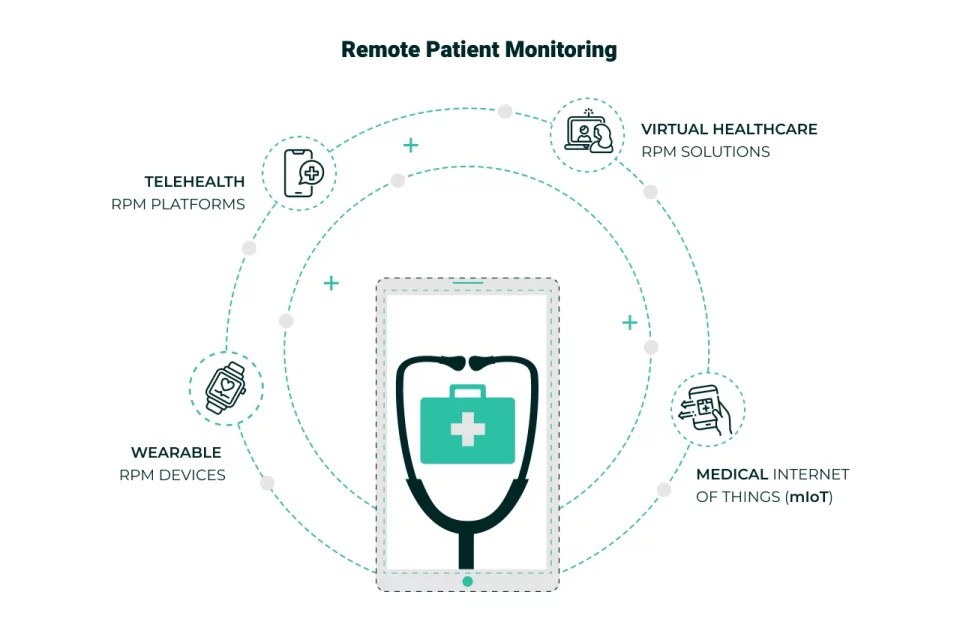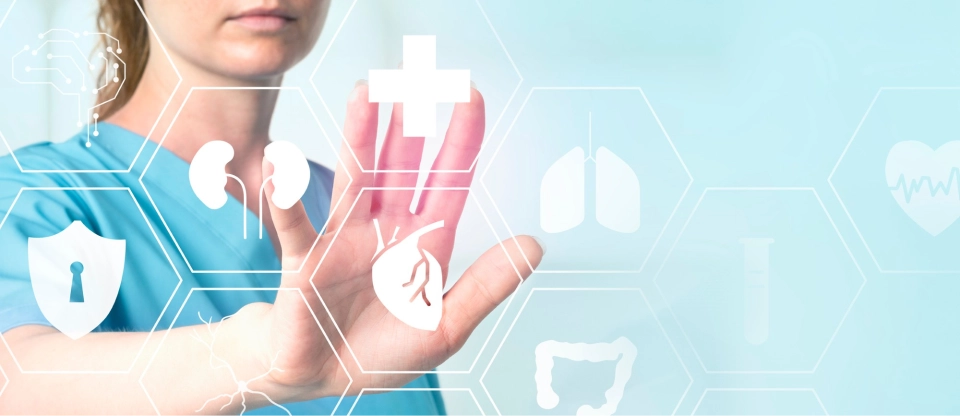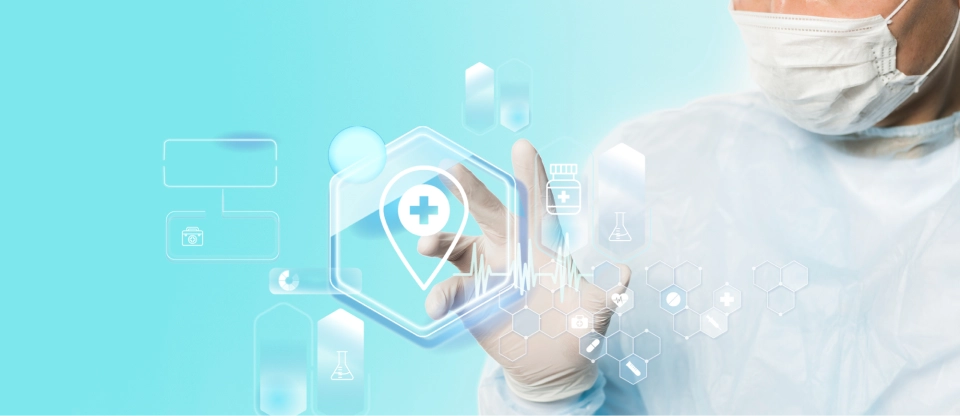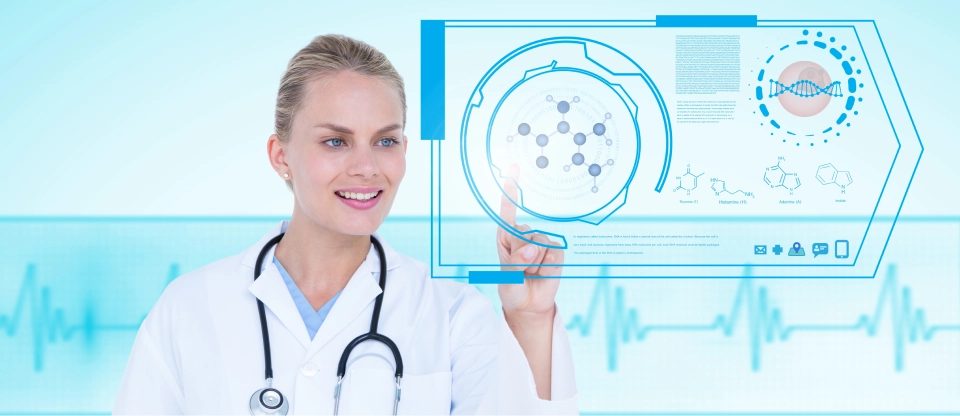INTRODUCTION
How is remote patient monitoring improving healthcare access and convenience?
Remote patient monitoring (RPM) is the use of medical devices, healthcare practice management software, hardware integrations, and new technologies such as wearables and smart homes hooked into the medical internet of things (MIoT).
RPM builds quicker feedback loops between patients and providers, reducing the need for time-consuming and expensive emergency services.
As remote patient monitoring tool usage increases, the cost of care drops, and patients receive more efficient and timely medical services.
Virtual care solutions, telehealth, and RPM act as vital touchpoints linking patients and providers across an increasingly distributed remote community health network. As healthcare organizations build an end-to-end health ecosystem, custom RPM solutions act as bridge points connecting patients in rural and underserved communities to more robust home-based treatment options to improve preventative medicine.
TRENDS
The gradual growth of the remote patient monitoring market
Definitive Healthcare reports that between 2019 and 2022, remote patient monitoring-related insurance claims increased by 1,300%.
They found conclusive data from payers, electronic health record software vendors, and hospital operations analytics data showing the rapid growth of this innovative new medical practice approach.
The largest increases were seen across internal medicine specialists whose usage of RPM increased by 30% in the last three years.
RPM adoption and implementation is steadily increasing because providers see the value in the cost-savings it drives. These tools are often paired with complementary digital health services such as virtual care, telemedicine, telehealth, and patient portals to create better feedback loops to improve patient medical health outcomes.
RPM automates clinical workflows to improve accuracy and drive better medical outcomes.
Patients who engage with RPM tools are more likely to follow medical guidelines, leading to better outcomes. RPM saves lives, reduces costs, and drives more efficient distance-based medical care.
The RPM systems market is worth $745.7 million in 2022 but is projected to increase by 128% to $1.7 billion by 2027.
Want to know how you can leverage technology to improve patient monitoring?
ADOPTION
Uses of remote patient monitoring in healthcare
RPM software and hardware solutions are being rapidly adopted across healthcare and clinical medical practice settings.
“Heart disease, diabetes, and chronic lung disease are among the most prevalent and deadliest chronic illnesses in the U.S. It’s unsurprising then that specialists who see larger volumes of chronically ill patients with relatively intensive disease management needs are also the top users of RPM,” says data analytics firm Definitive Healthcare’s report.
RPM is a valuable tool that extends the reach of healthcare organizations, providing the agility to improve medical outcomes dramatically.
Generally, cloud computing is integrated with wireless sensor networks to enable remote monitoring systems, improving the quality of service. The sensed patient data are monitored with biosensors without considering the patient data type, and this minimizes the work of hospitals and physicians.
Wearable sensor devices and MIoT have changed health services, resulting in faster monitoring, prediction, diagnosis, and treatment. Nevertheless, difficulties need to be resolved using AI methods.” writes Ahia et al.
One of the main reasons it makes sense to adopt and implement advanced RPM capabilities is to protect your organization against an uncertain economic future. Digital transformation is the way to strengthen your position against a rapidly evolving and more competitive healthcare business environment.
The winners of tomorrow will be the healthcare enterprises that complete strategic investments to increase resources and expertise in critical areas of advancement, such as digital health, telehealth, automation, and the interoperability of personal health information across the community health matrix.
Remote patient monitoring wearables, virtual health, and the MIoT seamlessly link patients to their healthcare services. Here are some of the most compelling use cases for remote patient monitoring solutions.
EXAMPLES
RPM use cases in healthcare

Remote patient monitoring extends the reach of healthcare organizations
Mobile health apps will enable physicians and specialists to communicate remotely, staying in touch regardless of location. Various healthcare software solutions are being created to increase patient happiness and expedite communication between hospitals and patients,” researchers Haleem et al. wrote in a paper titled, "Medical 4.0 Technologies for Healthcare: Features, capabilities, and Applications" in the peer-reviewed journal Internet of Things and Cyber-Physical Systems.
Wearable remote patient monitoring devices
Wearables and other patient-facing remote monitoring technologies form the first layer of digital health 2.0: seamlessly linking medical professionals with their patients across a distributed medical internet of things.
Blood pressure sensor: Bluetooth blood pressure sensors relay clinical data about the patient’s blood pressure in real-time.
Clinical observation tools: Monitoring solutions allow clinicians to observe patient behaviors to provide more reliable therapeutic guidance and medical decision-making.
Glucometer: More than 11% of the U.S. population is diabetic, with a new diagnosis every 17 seconds—glucometers are vital in monitoring patients with Type 1 and Type 2 diabetes.
Pulse oximeter: Many new wearables, such as smartwatches, activity monitors, and mobile phones, contain software that monitors oxygen levels.
Hospital-at-home: Smart homes of the future will be outfitted with a wide range of diagnostic tools, bridging the gap between patient and provider through remote clinical services.
ECG + stethoscope: Digital stethoscope tools provide reliable real-time monitoring of the patient’s heart activity.
Activity trackers: Wearable tools to monitor step counts, stairs climbed, and other health and wellness targets.
Digital wellness devices: Many devices and doctor-on-demand apps provide remote mental health and wellness check-up opportunities for patients wishing to access these services on an on-demand, as-needed basis.
Thermometer: Simple solutions monitor vital signs such as temperature, providing real-time data connections between patients and providers on the medical Internet of things.
Scales: Mobile phone apps and other wearable medical devices monitor patient activity levels and weight fluctuations.
Virtual care remote patient monitoring use cases
Guide patients on seamless, holistic health and wellness journeys: Virtual healthcare solutions provide patients with the health insights they need to make informed decisions about their health and wellness to promote vitality and longevity.
Manage acute conditions remotely: RPM and telehealth solutions allow clinical teams to track vital signs and biomarkers between in-patient care visits.
Stabilize critical patients at home: Telehealth and remote patient monitoring tools allow clinical care teams to monitor their patients’ recoveries remotely from their homes.
Build a more cohesive regional care network: Telehealth solutions link rural and homebound patients to vital life-saving services in their communities.
Strengthen competitive advantage: Strengthen your organization’s reputation by delivering world-class digital health experiences linked with virtual care opportunities and remote patient monitoring tools.
Medical Internet of Things remote patient monitoring use cases
The MIoT is the final layer that links patients and providers across the digital health ecosystem. It connects patients and providers across distributed medical devices, mobile and web applications, and cloud-powered solutions.
Here are some essential remote patient monitoring use cases for the medical internet of things:
- Spirometers
- Blood Pressure Cuff
- ECG and Digital Stethoscope
- Glucometer
- Weight Monitors
- Pulse Oximeter
Looking for healthcare IT solutions to set up remote patient monitoring software?
BENEFITS
Benefits of remote patient monitoring in the healthcare industry
Robotic process automation is one major component of RPM best practices that reduces the need for slow and time-consuming manual processes. RPM solutions round out digital health services and act as the perfect complement to telehealth platforms, patient portals, and other leading patient engagement tools.
Here are some of the main benefits of RPM adoption:
Value-based care
RPM positions your organization to improve clinical efficiencies at scale to enhance and streamline your in-patient and outpatient efficiency.
Real-time data
RPM provides access to on-demand treatment options and ability to monitor real-time data to improve decision-making.
Personalized patient journeys
Patient satisfaction is enhanced tremendously by RPM, as it reduces cost of care.
Streamlined medical teams
You can cut through time-consuming administrative tasks with more business process automation, real-time data analysis, and streamlined workflows to focus attention on what matters.






